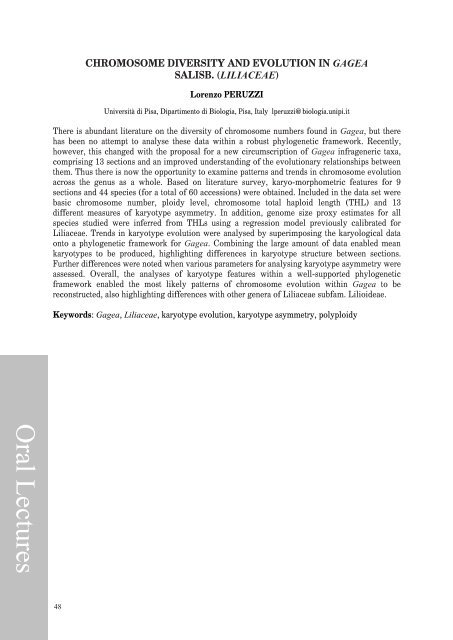Adil GÜNER, Vehbi ESER - optima
Adil GÜNER, Vehbi ESER - optima
Adil GÜNER, Vehbi ESER - optima
Create successful ePaper yourself
Turn your PDF publications into a flip-book with our unique Google optimized e-Paper software.
Oral Lectures<br />
48<br />
CHROMOSOME DIVERSITY AND EVOLUTION IN GAGEA<br />
SALISB. (LILIACEAE)<br />
Lorenzo PERUZZI<br />
Università di Pisa, Dipartimento di Biologia, Pisa, Italy lperuzzi@biologia.unipi.it<br />
There is abundant literature on the diversity of chromosome numbers found in Gagea, but there<br />
has been no attempt to analyse these data within a robust phylogenetic framework. Recently,<br />
however, this changed with the proposal for a new circumscription of Gagea infrageneric taxa,<br />
comprising 13 sections and an improved understanding of the evolutionary relationships between<br />
them. Thus there is now the opportunity to examine patterns and trends in chromosome evolution<br />
across the genus as a whole. Based on literature survey, karyo-morphometric features for 9<br />
sections and 44 species (for a total of 60 accessions) were obtained. Included in the data set were<br />
basic chromosome number, ploidy level, chromosome total haploid length (THL) and 13<br />
different measures of karyotype asymmetry. In addition, genome size proxy estimates for all<br />
species studied were inferred from THLs using a regression model previously calibrated for<br />
Liliaceae. Trends in karyotype evolution were analysed by superimposing the karyological data<br />
onto a phylogenetic framework for Gagea. Combining the large amount of data enabled mean<br />
karyotypes to be produced, highlighting differences in karyotype structure between sections.<br />
Further differences were noted when various parameters for analysing karyotype asymmetry were<br />
assessed. Overall, the analyses of karyotype features within a well-supported phylogenetic<br />
framework enabled the most likely patterns of chromosome evolution within Gagea to be<br />
reconstructed, also highlighting differences with other genera of Liliaceae subfam. Lilioideae.<br />
Keywords: Gagea, Liliaceae, karyotype evolution, karyotype asymmetry, polyploidy<br />
36






